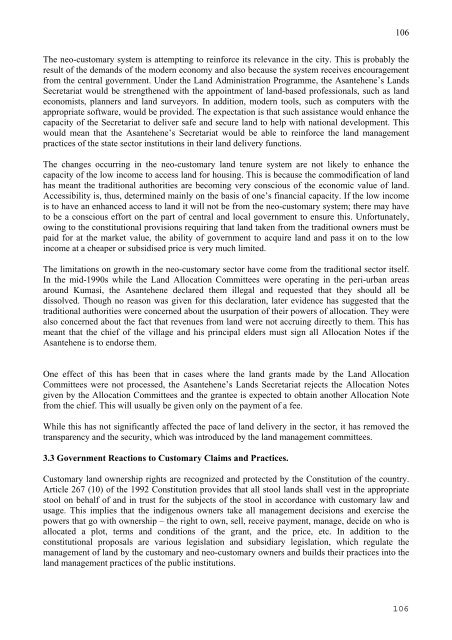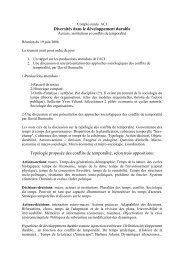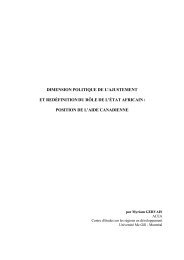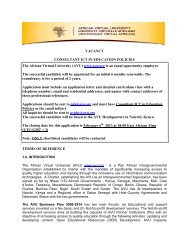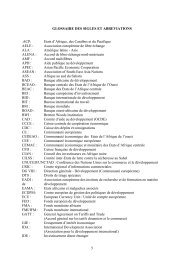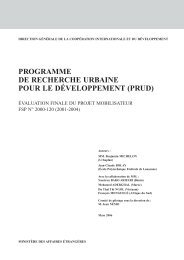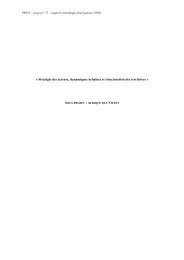Create successful ePaper yourself
Turn your PDF publications into a flip-book with our unique Google optimized e-Paper software.
106The neo-customary system is attempting to reinforce its re<strong>le</strong>vance in the city. This is probably theresult of the demands of the modern economy and also because the system receives encouragementfrom the central government. Under the Land Administration Programme, the Asantehene’s LandsSecretariat would be strengthened with the appointment of land-based professionals, such as landeconomists, planners and land surveyors. In addition, modern tools, such as computers with theappropriate software, would be provided. The expectation is that such assistance would enhance thecapacity of the Secretariat to deliver safe and secure land to help with national development. Thiswould mean that the Asantehene’s Secretariat would be ab<strong>le</strong> to reinforce the land managementpractices of the state sector institutions in their land delivery functions.The changes occurring in the neo-customary land tenure system are not likely to enhance thecapacity of the low income to access land for housing. This is because the commodification of landhas meant the traditional authorities are becoming very conscious of the economic value of land.Accessibility is, thus, determined mainly on the basis of one’s financial capacity. If the low incomeis to have an enhanced access to land it will not be from the neo-customary system; there may haveto be a conscious effort on the part of central and local government to ensure this. Unfortunately,owing to the constitutional provisions requiring that land taken from the traditional owners must bepaid for at the market value, the ability of government to acquire land and pass it on to the lowincome at a cheaper or subsidised price is very much limited.The limitations on growth in the neo-customary sector have come from the traditional sector itself.In the mid-1990s whi<strong>le</strong> the Land Allocation Committees were operating in the peri-urban areasaround Kumasi, the Asantehene declared them il<strong>le</strong>gal and requested that they should all bedissolved. Though no reason was given for this declaration, later evidence has suggested that thetraditional authorities were concerned about the usurpation of their powers of allocation. They werealso concerned about the fact that revenues from land were not accruing directly to them. This hasmeant that the chief of the village and his principal elders must sign all Allocation Notes if theAsantehene is to endorse them.One effect of this has been that in cases where the land grants made by the Land AllocationCommittees were not processed, the Asantehene’s Lands Secretariat rejects the Allocation Notesgiven by the Allocation Committees and the grantee is expected to obtain another Allocation Notefrom the chief. This will usually be given only on the payment of a fee.Whi<strong>le</strong> this has not significantly affected the pace of land delivery in the sector, it has removed thetransparency and the security, which was introduced by the land management committees.3.3 Government Reactions to Customary Claims and Practices.Customary land ownership rights are recognized and protected by the Constitution of the country.Artic<strong>le</strong> 267 (10) of the 1992 Constitution provides that all stool lands shall vest in the appropriatestool on behalf of and in trust for the subjects of the stool in accordance with customary law andusage. This implies that the indigenous owners take all management decisions and exercise thepowers that go with ownership – the right to own, sell, receive payment, manage, decide on who isallocated a plot, terms and conditions of the grant, and the price, etc. In addition to theconstitutional proposals are various <strong>le</strong>gislation and subsidiary <strong>le</strong>gislation, which regulate themanagement of land by the customary and neo-customary owners and builds their practices into theland management practices of the public institutions.106


